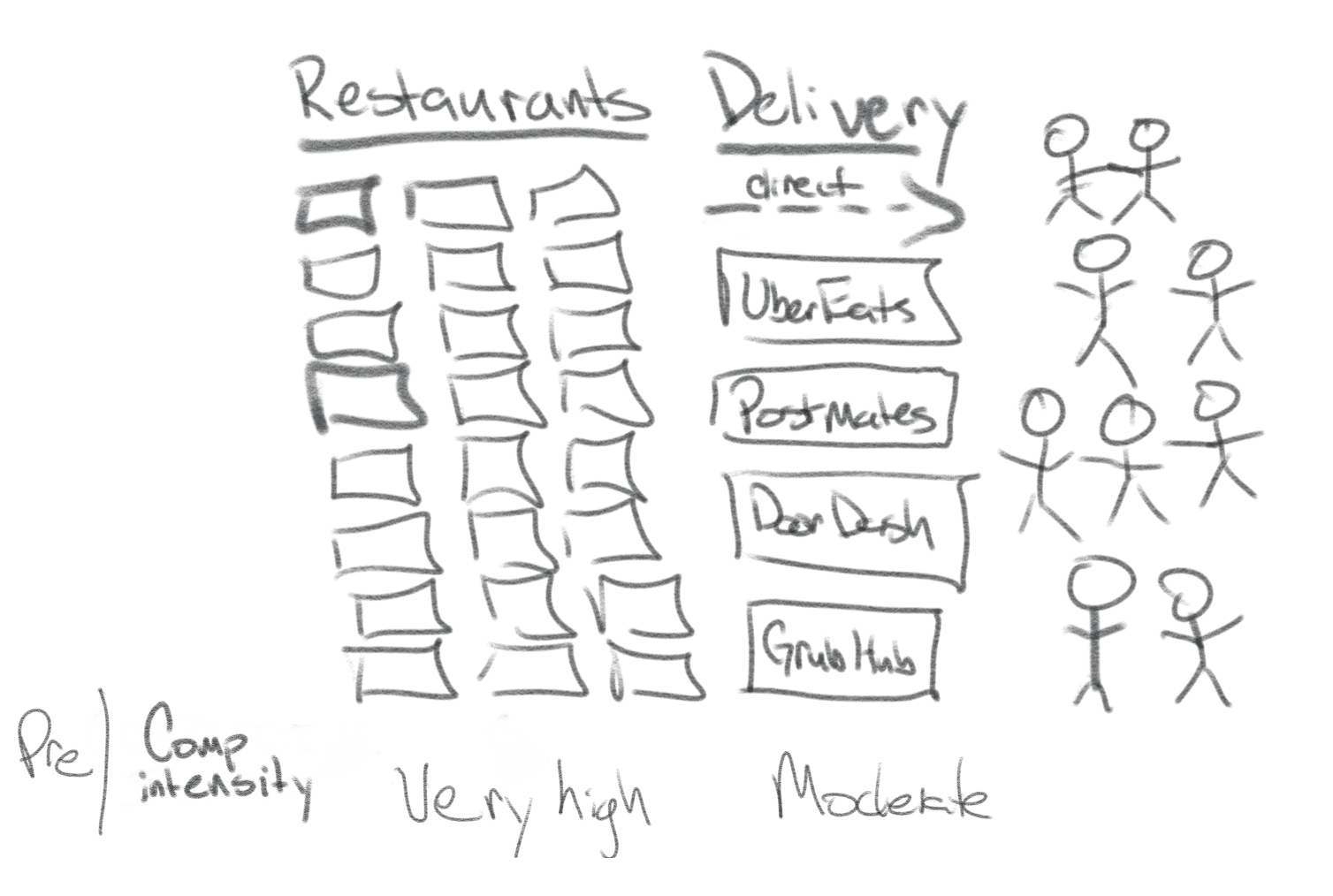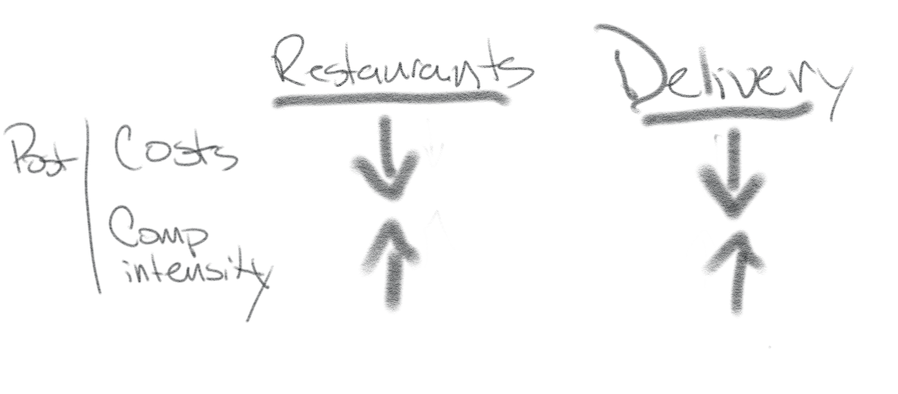In the last post, I concluded that ghost kitchens will be good for customers and for some restaurant entrepreneurs.
But what do they mean for everyone else?
A helpful starting point is a simple model of the food delivery market today (pre-ghost kitchens):

Key points:
- Some restaurants still take delivery orders directly from customers and have their own delivery drivers, but the majority of the delivery market goes through the big app-based players (GrubHub orders are partly fulfilled by GrubHub drivers and partly by the restaurants)
- Competitive intensity is high in most parts of the value chain (although delivery is less competitive in some geographical markets)
Ghost kitchens will have three main effects:
- Reduce the overall costs of food delivery (as discussed last week)
- Make delivery more affordable for customers and increase the size of the delivery market
- Increase competitive intensity for restaurants and delivery apps

More affordable delivery, larger delivery market
Given the competitive intensity at each stage of the value chain, a large portion of the overall cost savings will translate to lower prices for customers. Lower prices will support a larger market. (Although to be fair, current prices may already be low due to competitive dynamics—in both cases I mean versus what otherwise would be the long-run prices and market size).
Increased competition for restaurants
Ghost kitchens will increase the competitive intensity for restaurants in several ways. Most notably, they will reduce the barriers to entry for starting a delivery-only restaurant and make it easier for successful formulas to expand. But they will also leverage their superior data (vis-a-vis their restaurant customers) to launch their own restaurant formulas, directly competing with restaurants.
Underpinning most of these initiatives are large swathes of data that not only allow "food entrepreneurs" to know where to set up new kitchens but also tell them what to serve. Local demographic data can be used to figure out what kind of food outlets would work in a specific locale, while real-time consumer and operational data can be meshed to adjust menu options and test out new things.
For example (from the WSJ):
CloudKitchens also operates its own delivery-only restaurants in the commissaries, with names like Excuse My French Toast, Egg the F* Out, and B*tch Don't Grill My Cheese.
This is not good news for existing restaurants outside the successful ones previously discussed who can take advantage of easily adding more delivery capacity.
Increased competition for delivery companies
Although a larger market and lower costs are potential positives for delivery companies, they come at the expense of more competition. Ghost kitchens will make the delivery market more competitive in several ways:
- Ghost kitchens will make it easier for restaurants to operate across multiple delivery platforms, making it easier for customers to switch between apps
- By expanding the size of the market, individual geographical markets will be more able to support more competitors (i.e., for the same market share percentage, a larger market means a better cost structure through the ability to bundle deliveries into single driver trips).
- Concentrating the pickup location for multiple restaurants (and therefore orders) will also have a similar effect: higher delivery route density even at the same market share level. Depending on existing density in a given geography, this could benefit the market share followers more than the leader
Taken together, these work to reduce any winner-take-all effects in the app delivery market and increase competition.
What does this mean for ghost kitchen companies themselves?
The food delivery market is a large and rapidly growing one—and every other part of its value chain is highly competitive—so the ghost kitchen companies could be in an attractive position if they can carve out a sustainable competitive advantage. But that seems unlikely.
The benefits of the business model are captured substantially by the economics of a single facility, so the benefits of additional scale are somewhat limited. But there are some: Operating many facilities will provide some learning benefits, allowing them to build and operate the facilities more efficiently. The larger they are, the more valuable the data they collect will be. They will also be better able to serve larger chain customers.
The market for the services of ghost kitchens will also be relatively competitive. In cities (where the value of these facilities is greatest), the markets will be large enough to support multiple competitors. Less densely populated markets may be too small to support a second entrant but also are less attractive for the model to begin with. In general, the barriers to entry are mostly low (and will be more so as the model is understood).
So the competitive advantages of the ghost kitchen companies are likely to be weak. Still, they may end up with the least competitive part of a very competitive value chain.
Moreover, ghost kitchen companies can still create significant value for themselves in the role of developer, transforming low-value properties into high productivity uses (and McDonald's has shown a real-estate centered strategy can deliver financial success).
